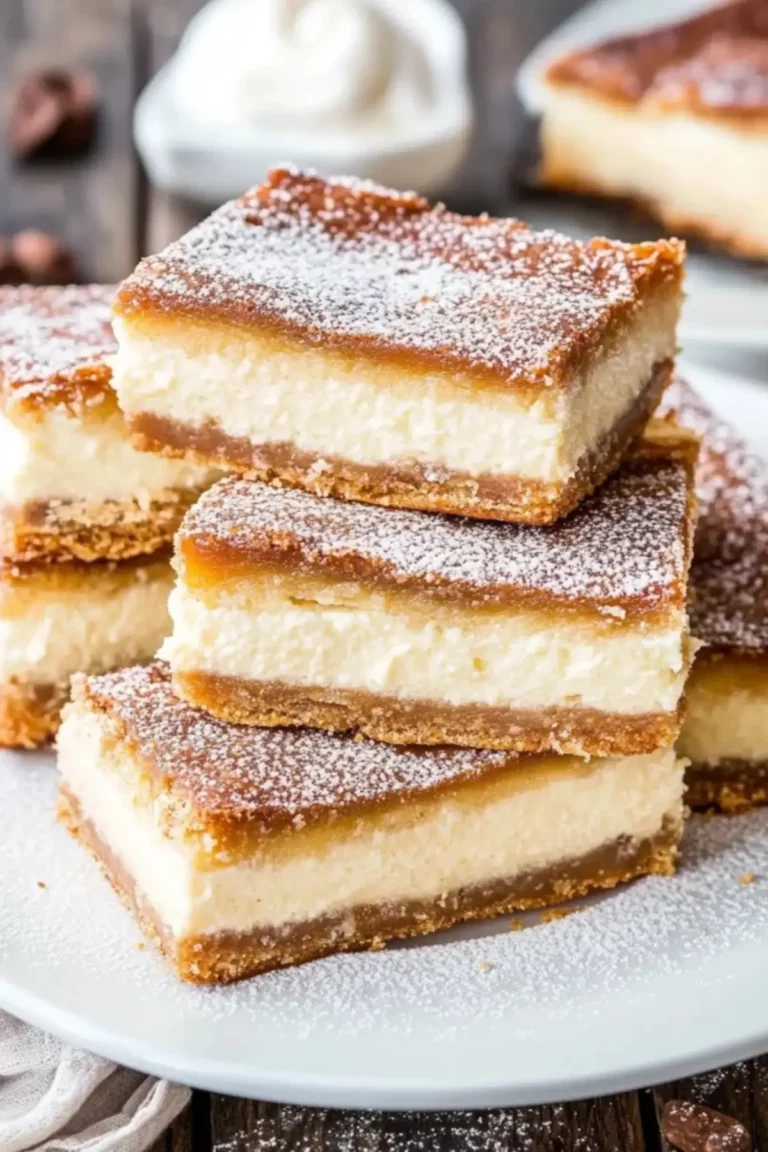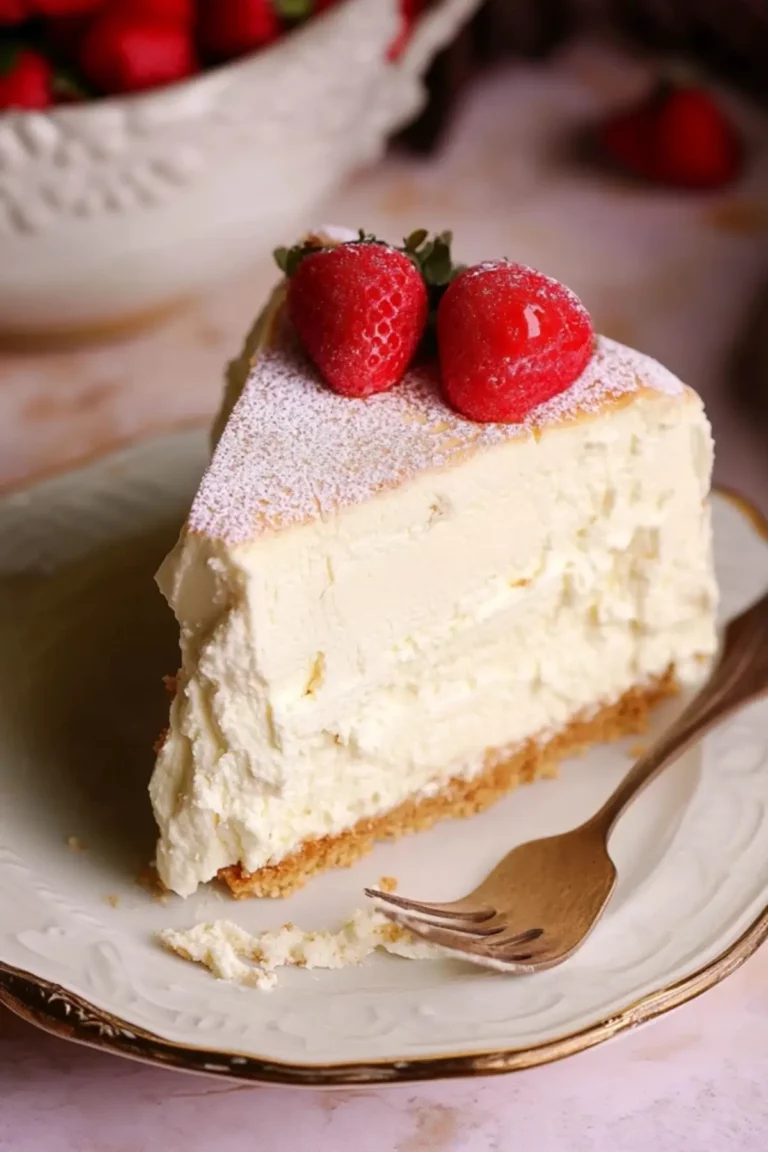The first time I tasted Japanese cotton cheesecake, I was mesmerized by its airy, melt-in-your-mouth texture. Unlike traditional cheesecakes, this one felt almost weightless, jiggling slightly when tapped. It had the perfect balance of sweetness and tang, making each bite delightful. As a beginner in baking at the time, I feared complex desserts, but this recipe surprised me—it was easier than I expected. If you’re new to baking and want to impress with minimal effort, this Japanese cotton cheesecake is the perfect place to start.
This recipe is ideal for beginners because it requires only a few staple ingredients and basic techniques like whipping egg whites and folding batter. The most critical part is patience—allowing the meringue to aerate the batter properly. With a few simple steps, you can achieve a beautifully fluffy, golden cheesecake that’s both light and creamy.
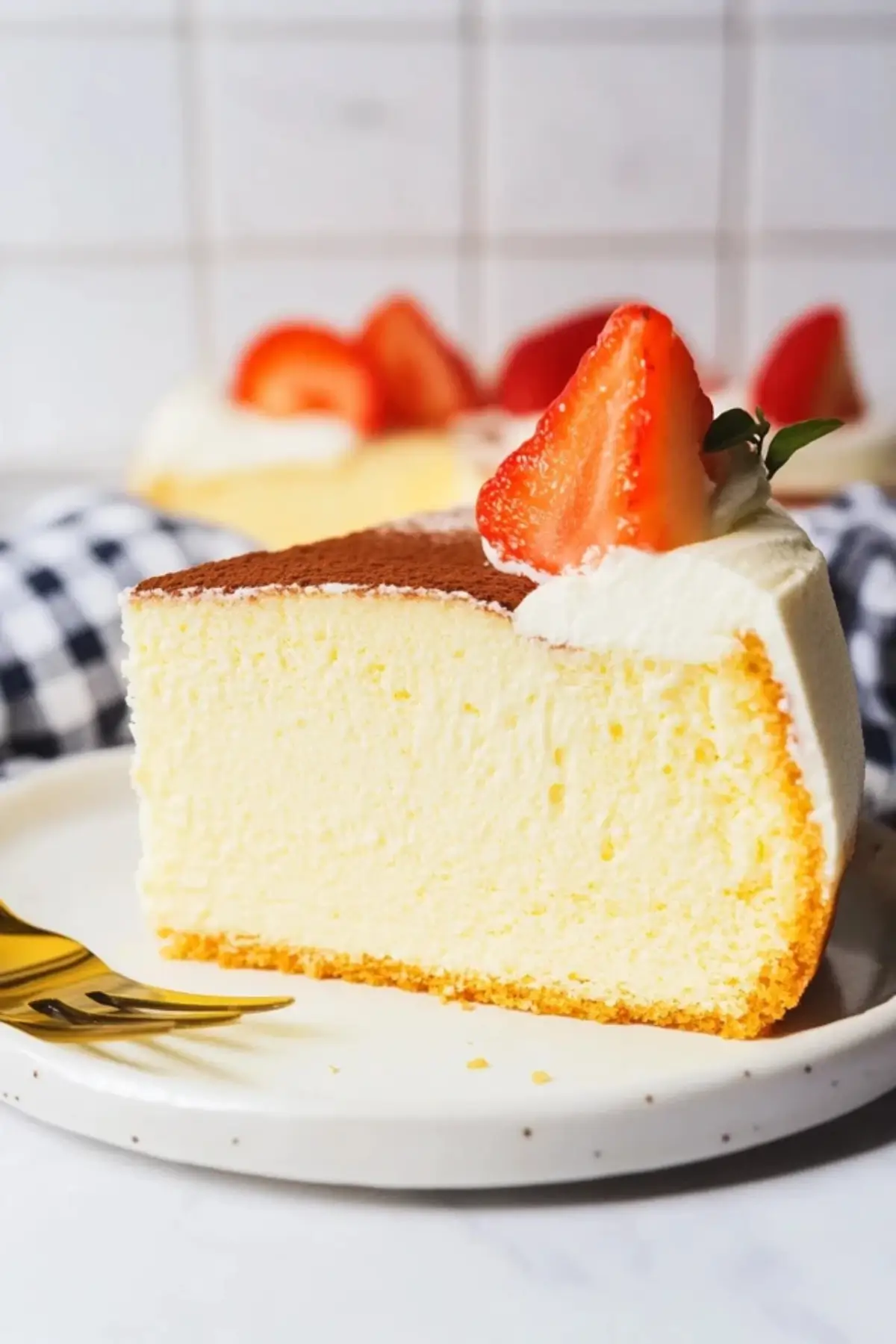
Why This Recipe is Special
- Unlike dense New York cheesecakes, Japanese cotton cheesecake is ultra-light and airy due to the meringue-based batter.
- It’s not overly sweet, making it perfect for those who enjoy subtle desserts.
- This cheesecake has a delightful balance of creaminess from cream cheese and freshness from lemon zest.
- It’s highly versatile—you can enjoy it plain, dusted with powdered sugar, or topped with fruits.
- Perfect for beginner bakers, as it doesn’t require fancy ingredients or equipment.
Ingredients and Preparation
Key Ingredients and Their Roles
- Eggs – The most essential ingredient for structure and texture. The yolks provide richness, while the whipped egg whites create a light, airy feel.
- Cream Cheese – The star of the recipe, giving the cake its signature creamy and slightly tangy flavor.
- Heavy Cream or Full-Fat Milk – Adds smoothness and moisture to the batter.
- Butter – Enhances the richness of the cake and ensures a soft texture.
- Cake Flour – Gives the cheesecake a delicate, fine crumb rather than a dense texture.
- Sugar – Sweetens the cake while helping to stabilize the meringue.
- Lemon Juice & Zest – Adds brightness and enhances the tangy notes of the cheesecake.
- Vanilla Extract – Provides depth of flavor and a warm, aromatic touch.
Substitutions and Variations
- If you don’t have cake flour, use all-purpose flour with a little cornstarch (for every 1 cup of all-purpose flour, remove 2 tablespoons and replace them with cornstarch).
- For a lactose-free version, swap heavy cream with full-fat coconut milk and butter with a plant-based alternative.
- If you prefer a citrusy twist, use orange zest instead of lemon zest.
- Add a touch of matcha powder for a subtle green tea flavor.
Step-by-Step Instructions
Step 1: Prepare Your Equipment and Ingredients
Preheat your oven to 300°F (150°C). Line the bottom of an 8-inch round cake pan with parchment paper. Prepare a larger baking dish for the water bath. Gather all ingredients so you can work smoothly.
Step 2: Melt the Base Ingredients
In a heatproof bowl over a bain-marie (a pot of simmering water), melt the cream cheese, butter, and heavy cream. Stir until smooth and well combined. Remove from heat.
Step 3: Mix the Batter
Once the melted mixture is slightly cooled, whisk in egg yolks, then sift in cake flour and gently fold until fully combined. Add lemon zest and vanilla extract, stirring lightly.
Step 4: Make the Meringue
In a separate clean, dry bowl, beat the egg whites with lemon juice until frothy. Gradually add the sugar, a little at a time, while beating until soft peaks form. The peaks should bend slightly when the whisk is lifted.
Step 5: Fold the Meringue Into the Batter
Take one-third of the meringue and gently fold it into the batter using a spatula. Repeat two more times, folding carefully to maintain the airiness of the mixture.
Step 6: Bake the Cheesecake
Pour the batter into the prepared cake pan. Tap the pan lightly on the counter to remove air bubbles. Place the cake pan into a water bath (a larger baking dish filled with hot water about 1 inch deep). Bake for 80 to 90 minutes or until the top is golden brown and a skewer inserted comes out clean.
Step 7: Cool and Serve
Turn off the oven and let the cake sit inside with the door slightly open for 15 minutes to prevent sudden shrinkage. Once removed, let it cool completely before slicing. You can enjoy it warm, at room temperature, or chilled after refrigerating for an hour.
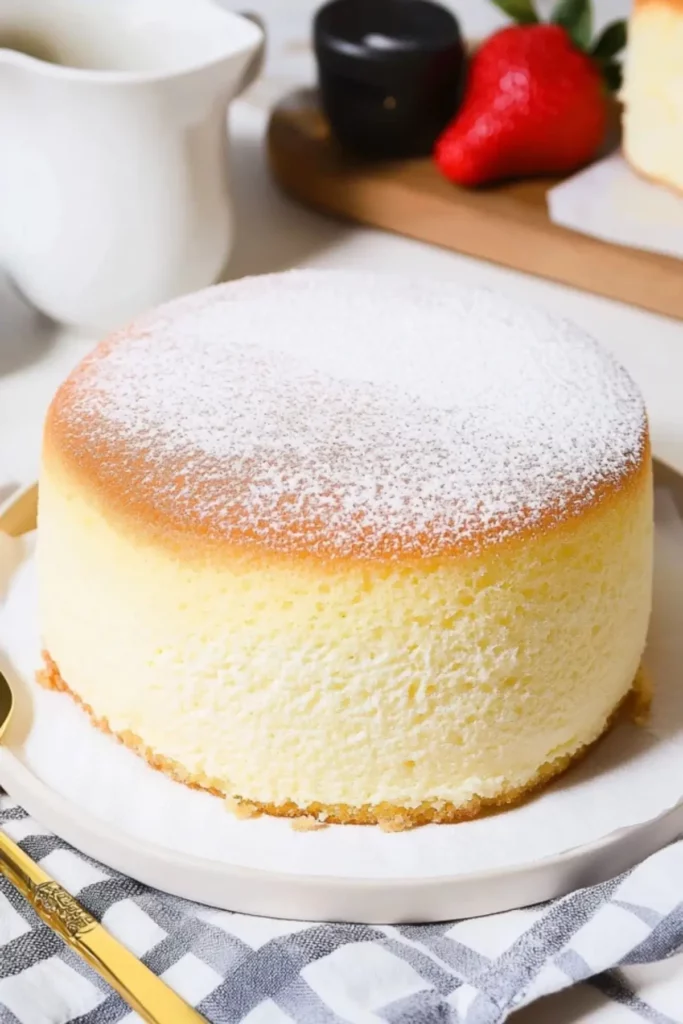
Beginner Tips and Notes
- Whip egg whites properly – If under-whipped, the cake will be too dense; if over-whipped, it may crack. Aim for soft-medium peaks.
- Don’t rush folding the batter – Use slow, gentle motions to keep the air bubbles intact for a fluffy texture.
- Prevent cracks – Ensure the oven temperature is accurate and use a water bath to maintain moisture.
- Use an oven thermometer – Many ovens run hotter or colder than their settings. A thermometer helps you bake at the right temperature.
- If the top is too pale, broil it for 1-2 minutes, but watch carefully to avoid burning.
Serving Suggestions
- Classic Style – Dust with powdered sugar for a simple yet elegant presentation.
- Fruity Delight – Top with fresh berries, mango slices, or kiwi for extra sweetness and color.
- Sweet Glaze – Brush with apricot jam for a glossy, slightly tangy finish.
- With a Beverage – Pair with green tea, coffee, or a light fruit tea to balance the cake’s creamy texture.
Storage Tips
- Store leftovers in an airtight container in the fridge for up to 4 days.
- To freeze, slice the cheesecake and wrap each piece individually in plastic wrap. Store in a freezer-safe container for up to 2 months. Thaw overnight in the fridge before serving.
Conclusion: Try This Fluffy Cheesecake Today!
If you’ve never made Japanese cotton cheesecake before, now is the perfect time to try. It’s a beginner-friendly recipe with a luxurious, cloud-like texture that will impress your family and friends. Follow these simple steps, and you’ll have a picture-perfect cheesecake in no time. Once you’ve tried it, don’t forget to share your experience in the comments. Happy baking!
FAQ About Japanese Cotton Cheesecake
Why did my cheesecake deflate so much after baking?
A slight shrinkage is normal, but excessive deflation may be due to under-whipped meringue, underbaking, or sudden temperature changes. To prevent this, ensure your meringue reaches soft-medium peaks, bake at the correct temperature, and cool the cheesecake gradually in the oven with the door slightly open.
Why did my Japanese cheesecake crack on top?
Cracks often occur due to over-whipped meringue, high oven temperature, or skipping the water bath. Ensure your meringue is at soft peaks, bake at 300°F, and always use a water bath for even heat distribution.
Can I make Japanese cheesecake without a water bath?
A water bath is highly recommended as it helps the cheesecake bake evenly and prevents cracks. If you don’t have a pan large enough, place a tray of hot water on the bottom oven rack to create steam.
More Relevant Recipes
- Million Dollar Cake
- The Best Fudgy Chewy Browkies (Brookies) – Savvy Bites
- Raspberry Cinnamon Rolls with Lemon Glaze
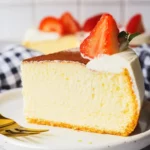
Japanese Cotton Cheesecake Recipe | Two Plaid Aprons
- Total Time: 1 hour 35 minutes
- Yield: 8 servings 1x
- Diet: Vegetarian
Description
This Japanese Cotton Cheesecake is a fluffy, light-as-air dessert with a creamy yet delicate texture. Perfectly balanced in sweetness with a hint of tangy lemon, it melts in your mouth with every bite. Ideal for beginners, this easy-to-follow recipe ensures a soft, jiggly cheesecake that’s both visually stunning and irresistibly delicious.
Ingredients
- 6 large eggs, separated
- 8 ounces cream cheese, softened
- ¼ cup heavy cream (or full-fat milk)
- 4 tablespoons unsalted butter, cut into small pieces
- ½ cup cake flour, sifted
- 1 tablespoon lemon zest (about 1 lemon, optional)
- 1½ teaspoons vanilla extract (optional)
- ⅓ cup granulated sugar
- 2 teaspoons lemon juice (about ⅓ of a lemon)
- Powdered sugar (for dusting, optional)
- Apricot jam (for glazing, optional)
Instructions
- Prepare the oven and pan: Preheat the oven to 300°F (150°C). Line the bottom of an 8-inch round cake pan with parchment paper. Prepare a large baking dish for a water bath by filling it with 1 inch of hot water.
- Melt the base ingredients: In a heatproof bowl over a bain-marie (a pot of simmering water), combine the cream cheese, butter, and heavy cream. Stir continuously until the mixture is smooth and well combined. Remove from heat and let it cool slightly.
- Mix the batter: Once the melted mixture is warm but not hot, whisk in the egg yolks one at a time. Sift in the cake flour and gently fold until no dry flour remains. Add the lemon zest and vanilla extract, stirring until incorporated.
- Prepare the meringue: In a clean, grease-free bowl, beat the egg whites with lemon juice until frothy. Gradually add sugar while beating on medium-high speed until soft peaks form. The peaks should bend slightly when the whisk is lifted.
- Incorporate the meringue: Take one-third of the meringue and gently fold it into the batter using a spatula. Repeat this two more times, folding carefully to maintain the airiness. Avoid over-mixing, as this will deflate the batter.
- Bake the cheesecake: Pour the batter into the prepared cake pan and tap it lightly on the counter to release air bubbles. Place the cake pan into the water bath and bake for 80 to 90 minutes, or until the top is golden brown and a skewer inserted in the center comes out clean.
- Cool the cheesecake: Turn off the oven and leave the cheesecake inside with the door slightly open for 15 minutes. This prevents sudden temperature changes that can cause shrinking. Transfer to a wire rack to cool completely before removing from the pan.
- Serve and enjoy: Dust the cheesecake with powdered sugar or glaze with apricot jam for a glossy finish. Enjoy it warm, at room temperature, or chilled for an even creamier texture.
Notes
- If the top is not golden brown after baking, broil for 1-2 minutes while watching carefully.
- To prevent cracks, always use a water bath and avoid over-whipping the meringue.
- Store leftovers in an airtight container in the fridge for up to 4 days. Cheesecake can also be frozen for up to 2 months.
- If using a springform pan, wrap it tightly with foil to prevent water from seeping into the batter.
- Prep Time: 15 minutes
- Cook Time: 80 minutes
- Category: Dessert
- Method: Baking
- Cuisine: Japanese
Nutrition
- Serving Size: 1 slice (1/8 of cheesecake)
- Calories: 222 kcal
- Sugar: 10.4 g
- Sodium: 255 mg
- Fat: 12.4 g
- Saturated Fat: 6.7 g
- Unsaturated Fat: 4.7 g
- Trans Fat: 0.2 g
- Carbohydrates: 16.9 g
- Fiber: 0.3 g
- Protein: 10.4 g
- Cholesterol: 166 mg


